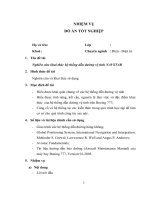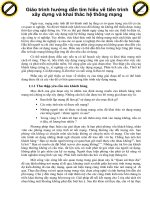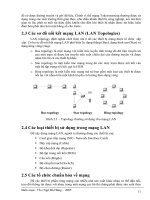HƯỚNG DẪN KHAI THÁC HỆ THỐNG AIS JHS 180
Bạn đang xem bản rút gọn của tài liệu. Xem và tải ngay bản đầy đủ của tài liệu tại đây (942.23 KB, 74 trang )
JHS-180
Automatic Identification System
INSTRUCTION MANUAL
For further information contact:
Since 1915
HEAD OFFICE &
SALES DEPT.
Nittochi Nishi-Shinjuku bldg.
10-1, Nishi-Shinjuku 6-chome, Shinjuku-ku,
Tokyo 160-8328 JAPAN
Phone : +81-3-3348-0151
Fax
: +81-3-3348-3648
MAIN PLANT
1-1, Shimorenjaku 5-chome, Mitaka-shi,
Tokyo 181-8510 JAPAN
Phone : +81-422-45-9111
Fax
: +81-422-45-9110
CODE NO. 7ZPJD0173A
EDITION 3
JAN. 2003
JRC
JHS-180
Automatic Identification System
INSTRUCTION
MANUAL
Preface
Thank you for purchasing JHS-180 Automatic Identification System.
JHS-180 is the Class A shipborne equipment of the universal Automatic Identification System.
• Be sure to read this manual for full comprehension before using the equipment.
• Save this manual near at hand for quick reference in the future.
Make use of this manual when experiencing operation difficulties.
i
Before Operation
Concerning the symbols
This manual uses the following symbols to explain correct operation and to prevent
injury or damage to property.
The symbols and descriptions are as follows. Understand them before proceeding with
this manual.
ᎈ᎙᎕᎐᎕ᎎ
ᎊᎈ᎐᎖᎕፧
Indicates a warning that, if ignored, may
result in serious injury or even death.
Indicates a caution that, if ignored, may
result in injury or damage to property.
Examples of symbols
The ٌ symbol indicates caution (including DANGER and WARNING).
The illustration inside the ٌ symbol specifies the content of the caution
more accurately. (This example warns of possible electrical shock.)
The
symbol indicates that performing an action is prohibited.
The illustration inside the
symbol specifies the contents of the
prohibited operation. (In this example disassembly is prohibited.)
The ٨ symbol indicates operations that must be performed.
The illustration inside the ٨ symbol specifies obligatory instructions. (In
this example unplugging is the obligatory instruction.)
Concerning warning labels
A warning label is pasted to the top cover of this product.
Do not remove, damage or modify the label.
ii
Handling Precautions
ᎈ᎙᎕᎐᎕ᎎ
Do not disassemble or customize this unit.
electrical shock or malfunction.
Doing so may cause fire,
Do not use a voltage other than specified.
electrical shock or malfunction.
Doing so may cause fire,
Do not touch any parts where this warning label is pasted.
cause electrical shock.
Doing so may
iii
Handling Precautions
ᎊᎈ᎐᎖᎕፧
Do not use this equipment for anything other than specified.
Doing so may cause malfunction or damage to persons.
Do not turn the trimmer resistors or the trimmer capacitors on the PCB unit,
except when and if they need to be adjusted.
Doing so may cause malfunction or damage to persons. They are preset at
the factory.
Do not install this equipment in a place other than specified or in one with
excessive humidity, steam, dust or soot. Doing so may cause fire, electric
shock, malfunction or damage to persons.
Do not get this equipment wet or spill any liquids on or near this equipment.
Doing so may cause electrical shock or malfunction.
Do not place this equipment anywhere vibration or impact is likely to occur.
Doing so may cause a fall or damage to property and persons.
iv
External Views
NTE-180 AIS Transponder
NCM-722 AIS Controller
v
NQD-4190 Junction Box
NQE-3111 Connection Box
vi
NBD-577A Power Supply Unit
vii
CONTENTS
Preface .................................................................................................................. i
Before Operation .....................................................................................................ii
Handling Precautions .............................................................................................iii
CAUTIONS AGAINST HIGH VOLTAGE ................................................................ v
Cautions concerning treatment of electrocution victims ........................................ v
First aid ..................................................................................................................vi
External Views .......................................................................................................ix
CONTENTS ......................................................................................................... xiii
Abbreviations ........................................................................................................xv
1.GENERAL ........................................................................................
1-1
1.1 Outlines ..................................................................................................... 1-1
1.2 Features .................................................................................................... 1-1
1.3 Components .............................................................................................. 1-2
1.3.1 Standard Components ...................................................................... 1-2
1.3.2 Options .............................................................................................. 1-2
1.4 Configration ............................................................................................... 1-3
2.INSTALLATIONDIAGRAM ...............................................................2-1
3.PART NAMES AND FUNCTIONS ................................................... 3-1
4.DISPLAYS .......................................................................................3-1
5.OPERATION ....................................................................................
5-1
5.1 MENU TABLE.............................................................................................. 5-1
5.2 BASIC OPERATION.................................................................................... 5-2
5.2.1 Turning the power ON................................................................................ 5-2
5.2.1.1 Other Ships List..................................................................................... 5-2
5.2.1.2 Other Ship's Detail Information.............................................................. 5-3
5.2.2 Turning the power OFF .............................................................................. 5-4
5.2.3 Alarm.......................................................................................................... 5-5
5.2.3.1 Guard zone alarm ................................................................................. 5-5
5.2.3.2 Lost target alarm ................................................................................... 5-5
5.3 MAIN MENU ................................................................................................... 5-6
5.3.1 Message Menu .......................................................................................... 5-7
5.3.1.1 Edit and TX ........................................................................................... 5-8
5.3.1.2 TX Tray................................................................................................ 5-10
5.3.1.3 RX Tray ............................................................................................... 5-12
5.3.1.4 Interrogation ........................................................................................ 5-13
5.3.1.5 Long Range Message ......................................................................... 5-15
5.3.2 Destination Setting................................................................................... 5-16
5.3.2.1 Destination .......................................................................................... 5-17
viii
5.3.2.2 Waypoint Text ......................................................................................5-18
5.3.2.3 Estimated Time of Arrival (ETA) ...........................................................5-19
5.3.2.4 Waypoints ............................................................................................5-20
5.3.3 Navigation Information Setting .................................................................5-21
5.3.3.1 Navigational Status Information ...........................................................5-21
5.3.3.2 Persons On-Board ...............................................................................5-21
5.3.3.3 Type of Ship and Cargo Type ..............................................................5-22
5.3.3.4 Draught................................................................................................5-23
5.3.3.5 Height Over Keel .................................................................................5-23
5.3.4 Alarm Setting ............................................................................................5-24
5.3.4.1 Range ..................................................................................................5-24
5.3.4.2 Lost Target ...........................................................................................5-24
5.3.5 Group Ship Setting ...................................................................................5-25
5.3.5.1 Ship Name ...........................................................................................5-25
5.3.5.2 MMSI ...................................................................................................5-25
5.3.6 Setup menu ..............................................................................................5-26
5.3.6.1 Password Setting.................................................................................5-27
5.3.6.2 Channel Management Setting .............................................................5-28
5.3.6.3 Own Ship Data display setting .............................................................5-32
5.3.6.4 Long Range Response setting.............................................................5-32
5.3.6.5 Contrast setting....................................................................................5-33
5.3.6.6 Number of Retries Setting ...................................................................5-33
5.3.7 Maintenance menu ...................................................................................5-34
5.3.7.1 TRX Condition log display....................................................................5-35
5.3.7.2 AIS Alarm display.................................................................................5-36
5.3.7.3 Sensor Status display ..........................................................................5-36
5.3.7.4 Power On/Off Log display ....................................................................5-37
5.3.7.5 Password Log ....................................................................................5-37
5.3.7.6 Software Version display......................................................................5-37
6.MAINTENANCE AND INSPECTION ................................................6-1
6.1 General Maintenance and Inspection ..........................................................6-1
6.2 Maintenance Menu ......................................................................................6-1
7.AFTER-SALES SERVICE ................................................................. 7-1
Before returning repair....................................................................................... 7-1
Periodical maintenance recommended ............................................................ 7-1
8.SPECIFICATIONS ............................................................................8-1
8.1 NTE-180 AIS Transponder......................................................................... 8-1
8.2 NCM-722 AIS Controller .......................................................................... 8-1
8.3 NBD-577A Power Supply Unit .................................................................. 8-2
ix
1.
1.1
GENERAL
Outlines
Automatic Identification System (AIS) is a maritime navigation and radio communication system.
This system intends to enhance the safety of life at sea, the safety and efficiency of navigation
and the protection of the marine environment by communicating navigational information
automatically on VHF channels between ship and ship, ship and shore.
JHS-180 meets the requirements of the SOLAS Conventions for the Class A shipborne
equipment of the universal AIS. JHS-180 mainly consists of AIS Transponder and AIS Controller.
The combined antenna and transponder design allows installation at any convenient location on
any vessels. The small and simple design controller allows easy installation and operation.
JHS-180 employs the latest technologies such as digital signal processing, circuit integration
technology, and these technologies ensure high performance and high reliability.
1.2
Features
٨ Fully Comply with International Regulations
֤֤֤֤֤֤֤֤֤֤֤֤֤֤֤֤֤֤֤֤֤֤֤֤֤֤֤֤֤֤֤֤֤֤֤֤֤֤֤֤֤֤֤
JHS-180 is designed to meet the requirements of the SOLAS Conventions for the Class A
shipborne equipment of the universal AIS and fully complies with international regulations: IMO
MSC74(69) Annex 3, ITU-R M.1371, IEC61993-2, IEC60945 etc.
٨ Combined Antenna and Transponder for Ease of Installation
֤֤֤֤֤֤֤֤֤֤֤֤֤֤֤֤֤֤֤֤֤֤֤֤֤֤֤֤֤֤֤֤֤֤֤֤֤֤֤֤֤֤֤
JHS-180 employs the combined antenna and transponder design. This design allows installation
at any convenient location on any vessels. For the connection between abode deck component
and below deck component, only one cable is needed.
٨ Increased Probability of Vessel Detection
֤֤֤֤֤֤֤֤֤֤֤֤֤֤֤֤֤֤֤֤֤֤֤֤֤֤֤֤֤֤֤֤֤֤֤֤֤֤֤֤֤֤֤
JHS-180 is equipped with a guard zone alert function. When preset guard zone range and other
vessel enters into the zone, JHS-180 indicates and sounds the alert. This function enhances
probability of vessel detection.
٨ Recognition of Own-group Vessels
֤֤֤֤֤֤֤֤֤֤֤֤֤֤֤֤֤֤֤֤֤֤֤֤֤֤֤֤֤֤֤֤֤֤֤֤֤֤֤֤֤֤֤
JHS-180 is equipped with a recognition of own-group vessels function. When preset own-group
vessels’ identification in advance, the display indicates the own-group vessel sign. This sign
allows easy recognition of own-group vessels.
٨ Self-diagnosis Function
֤֤֤֤֤֤֤֤֤֤֤֤֤֤֤֤֤֤֤֤֤֤֤֤֤֤֤֤֤֤֤֤֤֤֤֤֤֤֤֤֤֤֤
JHS-180 is equipped with a built-in automatic self-diagnosis function. This function allows easy
maintenance and high system reliability.
٨ System Integration Availability
֤֤֤֤֤֤֤֤֤֤֤֤֤֤֤֤֤֤֤֤֤֤֤֤֤֤֤֤֤֤֤֤֤֤֤֤֤֤֤֤֤֤֤
JHS-180 is equipped with various interfaces. These interfaces allow system integration and future
expansions.
1-1
1.3
Components
1. 3. 1
Standard Components
No.
1
2
3
4
5
6
7
8
9
1. 3. 2
No.
1
2
3
1-2
Name
AIS Transponder
AIS Controller
Power Supply Cable
Control Cable 1
Junction Box
Connection Box
Power Supply Unit
Spare Parts
Instruction Manual
Type
NTE-180
NCM-722
7ZCJD0095
7ZCAF0078
NQD-4190
NQE-3111
NBD-577A
7ZXJD0027
Quantity
1
1
1
1
1
1
1
1
1
Type
7ZCAF0079
MPBP30837
MPBP30838
Quantity
1
1
1
Remarks
With 2m cable, Fitting belts
L=5m
L=5m
Fuses
Options
Options
Control Cable 2
Flash Mount Kit
Flash Mount Kit
Remarks
L=5m
Color: 2.5G7/2
Color: 7.5BG7/2
1.4
Configuration
• System Block Diagram
1-3
• Outline Drawing of NTE-180 AIS Transponder
֤֤֤֤֤֤֤֤֤֤֤֤֤֤֤֤֤֤֤֤֤֤֤֤֤֤֤֤֤֤֤֤֤֤֤֤֤֤֤֤֤֤֤
Unit: mm
Mass: approx. 3.3 kg
1-4
• Outline Drawing of NQD-4190 Junction Box
֤֤֤֤֤֤֤֤֤֤֤֤֤֤֤֤֤֤֤֤֤֤֤֤֤֤֤֤֤֤֤֤֤֤֤֤֤֤֤֤֤֤֤
Unit: mm
Mass: approx. 1.2 kg
1-5
• Outline Drawing of NCM-722 AIS Controller
֤֤֤֤֤֤֤֤֤֤֤֤֤֤֤֤֤֤֤֤֤֤֤֤֤֤֤֤֤֤֤֤֤֤֤֤֤֤֤֤֤֤֤
Unit: mm
Mass: approx. 2.0 kg
1-6
• Outline Drawing of NQE-3111 Connection Box
֤֤֤֤֤֤֤֤֤֤֤֤֤֤֤֤֤֤֤֤֤֤֤֤֤֤֤֤֤֤֤֤֤֤֤֤֤֤֤֤֤֤֤
Unit: mm
Mass: approx. 5.5 kg
1-7
• Outline Drawing of NBD-577A Power Supply
֤֤֤֤֤֤֤֤֤֤֤֤֤֤֤֤֤֤֤֤֤֤֤֤֤֤֤֤֤֤֤֤֤֤֤֤֤֤֤֤֤֤֤
Unit: mm
Mass: approx. 10.0 kg
1-8
Notes:
2.
INSTALLATION DIAGRAM
Leave installation of this equipment to our service center or agents.
Installation by an unauthorized person may results in malfunction.
2-1
3. PART NAMES AND FUNCTIONS
(1) LCD Panel
(2) Menu key
(3) Arrow Keys
(4) Numerical Keys
(5) Enter key
(6) Alarm off
/CLR key
(7) Select-1 key
(8) Select-2,3,4
keys
(9) Power/Dimmer key
(10) Power OFF key
(1) LCD Panel
For further information, refer to “4. Display”.
(2) Menu key
Displays the Main-menu.
(3) Arrow Keys
Move the cursor upward, downward, to the left or to the right.
(4) Numerical Keys
Input the numerical data.
(5) Enter key
Confirms the input.
(6) Alarm off/CLR key
Clears input errors.
Off the alarm sound when beeping alarm sound.
(7) Select-1 key
Displays the Other Ships List.
(8) Select-2,-3,-4 keys
Operates functions of the each Display. See the Basic Operation and the Main Menu Operation.
(9) Power/Dimmer key
Turn the power ON.
Adjusts the back light brightness of the LCD and key in four stages.
(Each time [PWR/DIM] is pressed, the display dims one stage at a time.)
(10) Power OFF key
Pressing [PWR/DIM] and [OFF] at the same time turn the power OFF.
3-1
4.
Display Title
DISPLAYS
Current time
Minimum other ships list (three)
Other ships list,
Other ship’s detail information
or
Menu for operation
Status display line for alarm
and message reception
4-1









